Leadership and Organizational Behavior: Thomas Cook Case Study Report
VerifiedAdded on 2023/01/19
|12
|2990
|50
Report
AI Summary
This report provides an executive summary of Thomas Cook's organizational behavior, examining its structure, culture, and the impact on customer service and employee motivation. The analysis explores the influence of power, culture, politics, and motivation on workplace performance, highlighting the roles of content and process theories in employee motivation. The company's implementation of various motivational techniques, such as profit sharing and recognition, is discussed. The report also applies the Belbin team development theory to analyze team effectiveness and address team inefficiencies and conflicts to improve productivity. Finally, the report covers the concepts and philosophies of organizational behavior influencing behavior during day activity, including contingency theory, providing a comprehensive overview of Thomas Cook's organizational dynamics.

ORGANISATIONAL BEHAVIOR
Paraphrase This Document
Need a fresh take? Get an instant paraphrase of this document with our AI Paraphraser
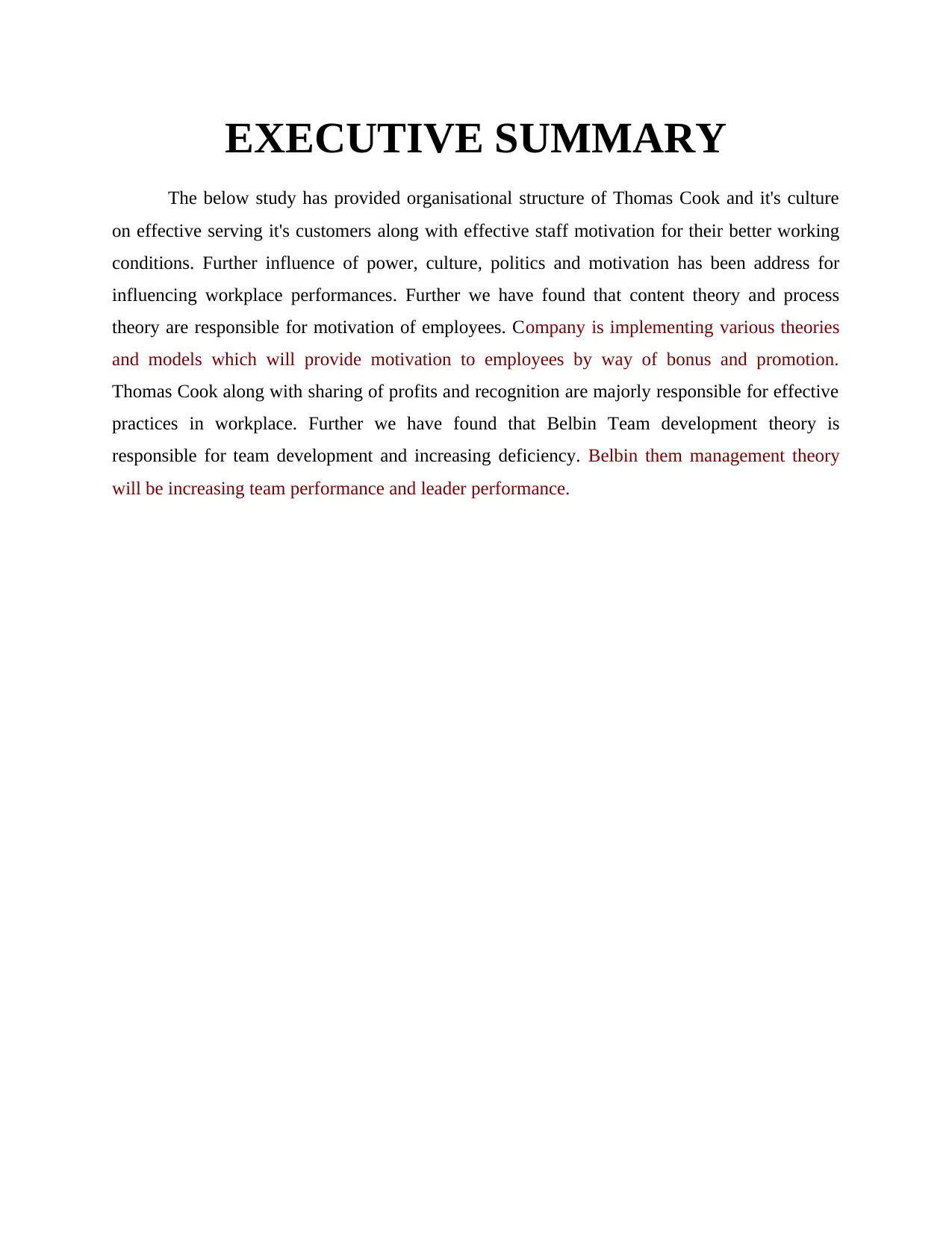
EXECUTIVE SUMMARY
The below study has provided organisational structure of Thomas Cook and it's culture
on effective serving it's customers along with effective staff motivation for their better working
conditions. Further influence of power, culture, politics and motivation has been address for
influencing workplace performances. Further we have found that content theory and process
theory are responsible for motivation of employees. Company is implementing various theories
and models which will provide motivation to employees by way of bonus and promotion.
Thomas Cook along with sharing of profits and recognition are majorly responsible for effective
practices in workplace. Further we have found that Belbin Team development theory is
responsible for team development and increasing deficiency. Belbin them management theory
will be increasing team performance and leader performance.
The below study has provided organisational structure of Thomas Cook and it's culture
on effective serving it's customers along with effective staff motivation for their better working
conditions. Further influence of power, culture, politics and motivation has been address for
influencing workplace performances. Further we have found that content theory and process
theory are responsible for motivation of employees. Company is implementing various theories
and models which will provide motivation to employees by way of bonus and promotion.
Thomas Cook along with sharing of profits and recognition are majorly responsible for effective
practices in workplace. Further we have found that Belbin Team development theory is
responsible for team development and increasing deficiency. Belbin them management theory
will be increasing team performance and leader performance.
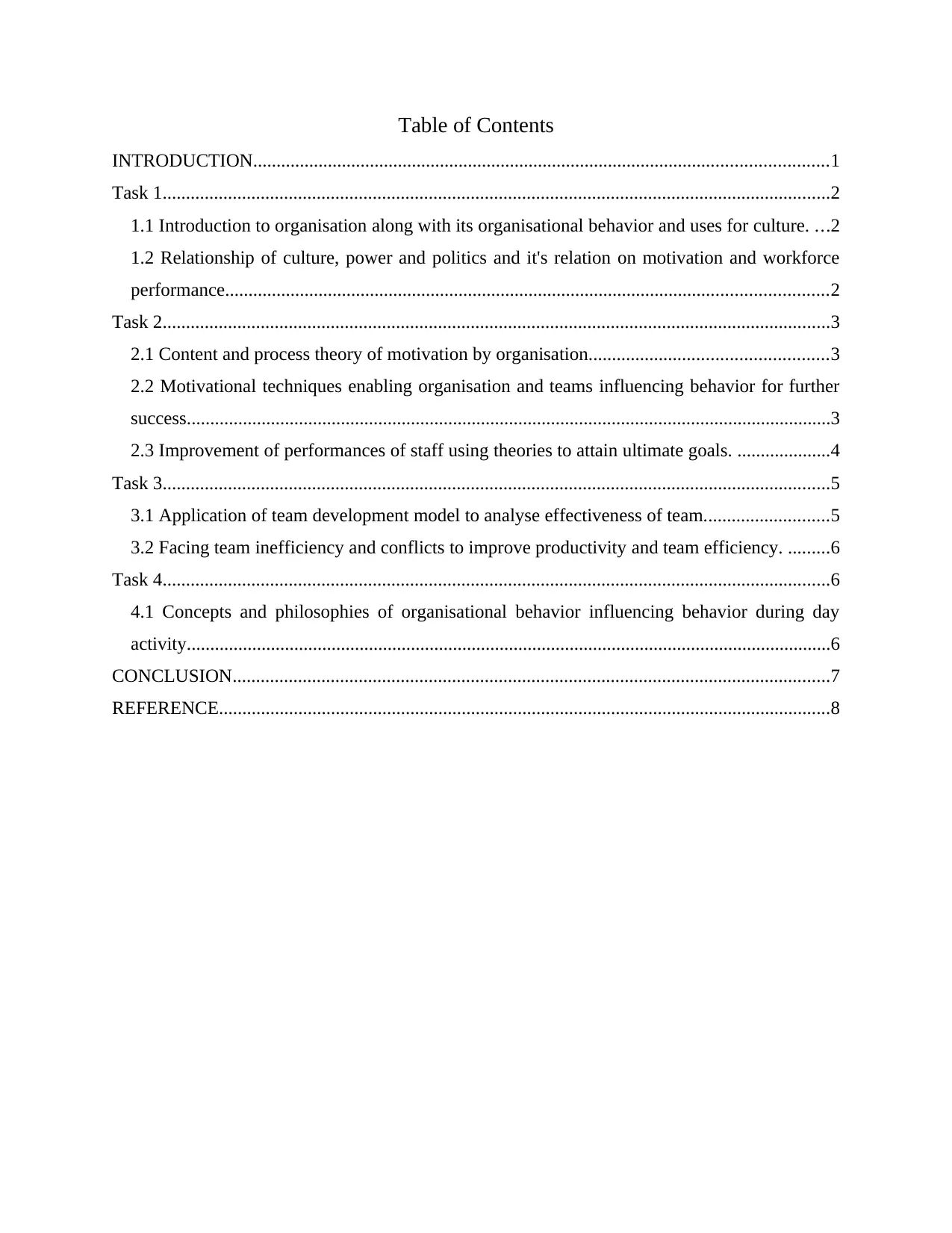
Table of Contents
INTRODUCTION...........................................................................................................................1
Task 1...............................................................................................................................................2
1.1 Introduction to organisation along with its organisational behavior and uses for culture. ...2
1.2 Relationship of culture, power and politics and it's relation on motivation and workforce
performance.................................................................................................................................2
Task 2...............................................................................................................................................3
2.1 Content and process theory of motivation by organisation...................................................3
2.2 Motivational techniques enabling organisation and teams influencing behavior for further
success..........................................................................................................................................3
2.3 Improvement of performances of staff using theories to attain ultimate goals. ....................4
Task 3...............................................................................................................................................5
3.1 Application of team development model to analyse effectiveness of team...........................5
3.2 Facing team inefficiency and conflicts to improve productivity and team efficiency. .........6
Task 4...............................................................................................................................................6
4.1 Concepts and philosophies of organisational behavior influencing behavior during day
activity..........................................................................................................................................6
CONCLUSION................................................................................................................................7
REFERENCE...................................................................................................................................8
INTRODUCTION...........................................................................................................................1
Task 1...............................................................................................................................................2
1.1 Introduction to organisation along with its organisational behavior and uses for culture. ...2
1.2 Relationship of culture, power and politics and it's relation on motivation and workforce
performance.................................................................................................................................2
Task 2...............................................................................................................................................3
2.1 Content and process theory of motivation by organisation...................................................3
2.2 Motivational techniques enabling organisation and teams influencing behavior for further
success..........................................................................................................................................3
2.3 Improvement of performances of staff using theories to attain ultimate goals. ....................4
Task 3...............................................................................................................................................5
3.1 Application of team development model to analyse effectiveness of team...........................5
3.2 Facing team inefficiency and conflicts to improve productivity and team efficiency. .........6
Task 4...............................................................................................................................................6
4.1 Concepts and philosophies of organisational behavior influencing behavior during day
activity..........................................................................................................................................6
CONCLUSION................................................................................................................................7
REFERENCE...................................................................................................................................8
You're viewing a preview
Unlock full access by subscribing today!
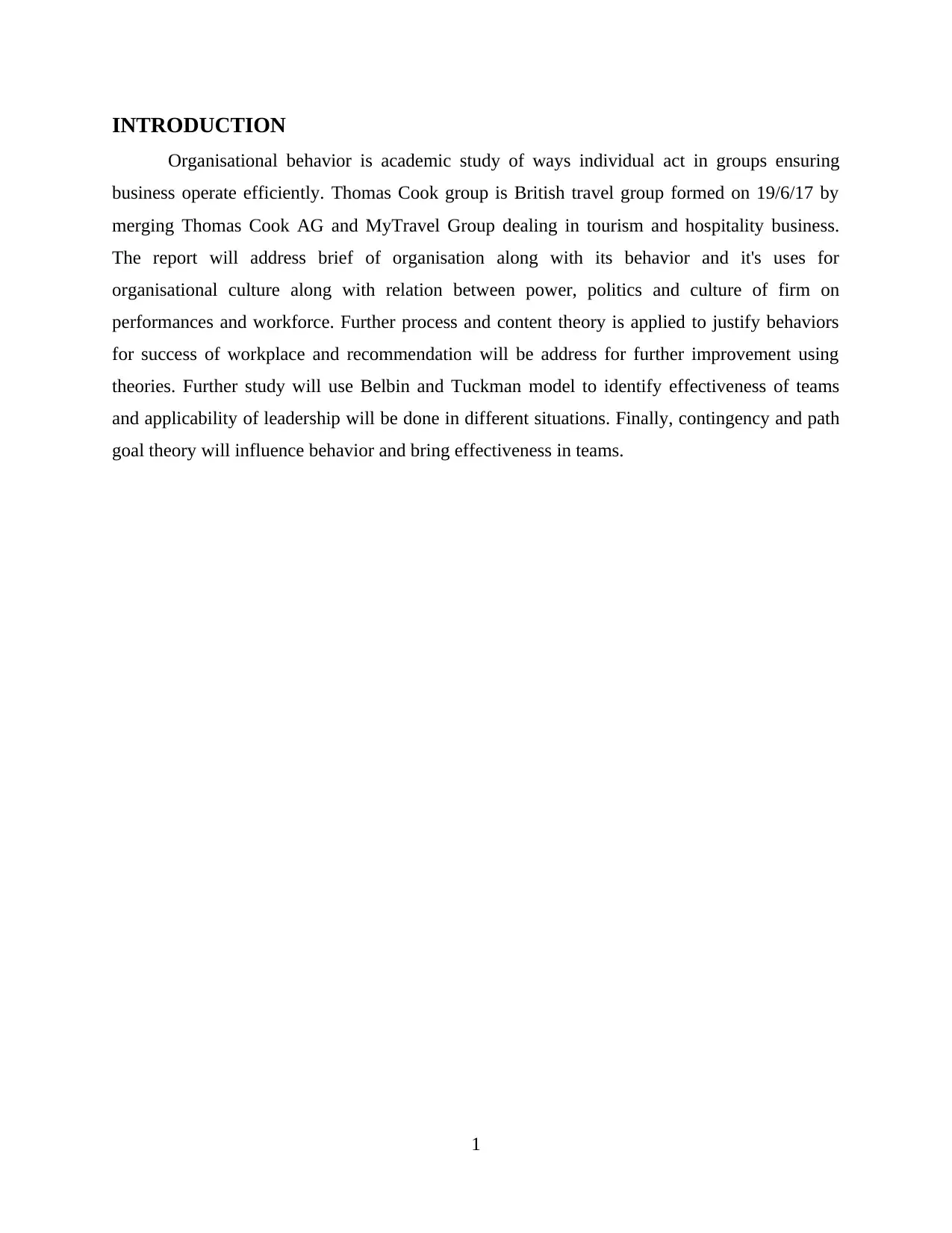
INTRODUCTION
Organisational behavior is academic study of ways individual act in groups ensuring
business operate efficiently. Thomas Cook group is British travel group formed on 19/6/17 by
merging Thomas Cook AG and MyTravel Group dealing in tourism and hospitality business.
The report will address brief of organisation along with its behavior and it's uses for
organisational culture along with relation between power, politics and culture of firm on
performances and workforce. Further process and content theory is applied to justify behaviors
for success of workplace and recommendation will be address for further improvement using
theories. Further study will use Belbin and Tuckman model to identify effectiveness of teams
and applicability of leadership will be done in different situations. Finally, contingency and path
goal theory will influence behavior and bring effectiveness in teams.
1
Organisational behavior is academic study of ways individual act in groups ensuring
business operate efficiently. Thomas Cook group is British travel group formed on 19/6/17 by
merging Thomas Cook AG and MyTravel Group dealing in tourism and hospitality business.
The report will address brief of organisation along with its behavior and it's uses for
organisational culture along with relation between power, politics and culture of firm on
performances and workforce. Further process and content theory is applied to justify behaviors
for success of workplace and recommendation will be address for further improvement using
theories. Further study will use Belbin and Tuckman model to identify effectiveness of teams
and applicability of leadership will be done in different situations. Finally, contingency and path
goal theory will influence behavior and bring effectiveness in teams.
1
Paraphrase This Document
Need a fresh take? Get an instant paraphrase of this document with our AI Paraphraser
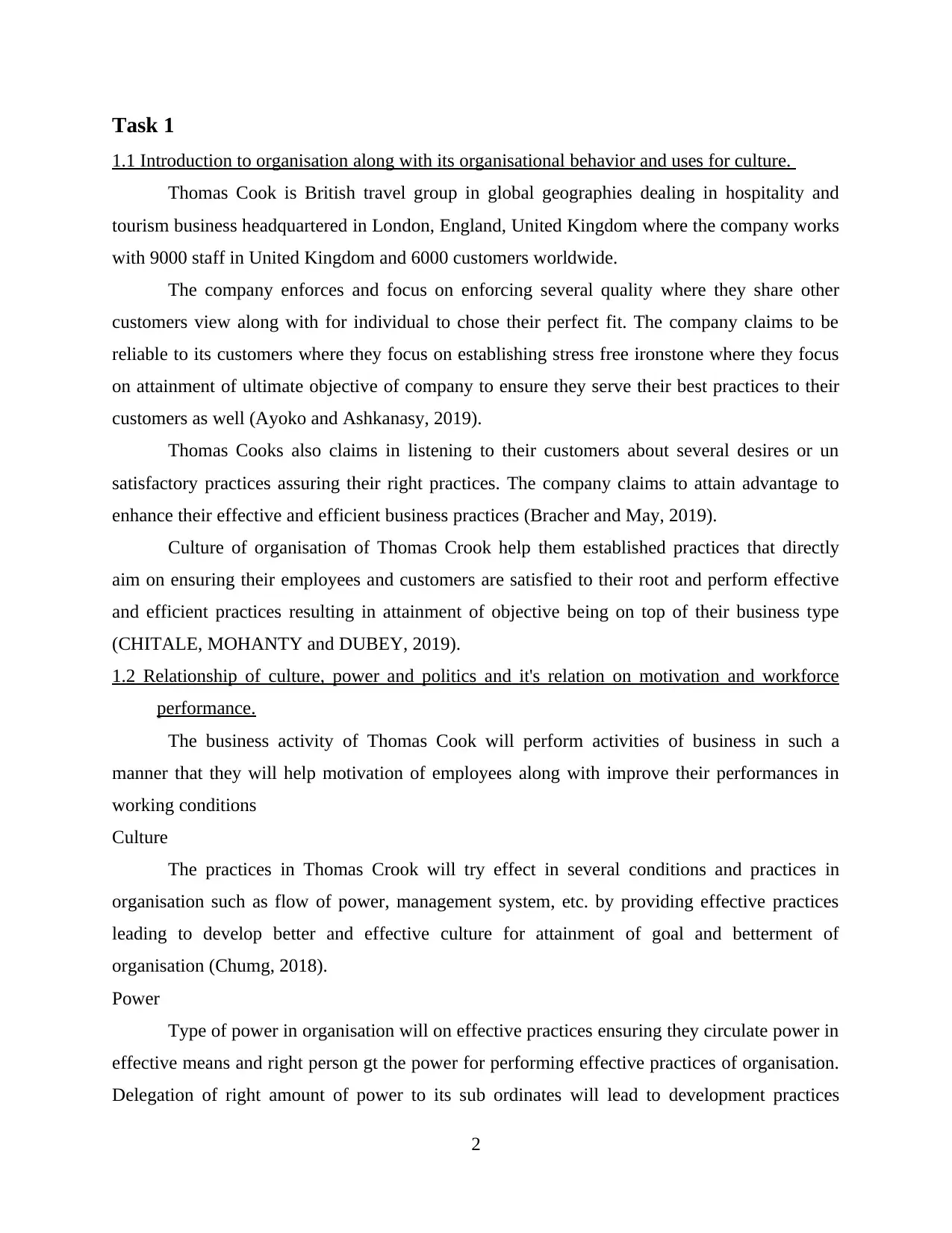
Task 1
1.1 Introduction to organisation along with its organisational behavior and uses for culture.
Thomas Cook is British travel group in global geographies dealing in hospitality and
tourism business headquartered in London, England, United Kingdom where the company works
with 9000 staff in United Kingdom and 6000 customers worldwide.
The company enforces and focus on enforcing several quality where they share other
customers view along with for individual to chose their perfect fit. The company claims to be
reliable to its customers where they focus on establishing stress free ironstone where they focus
on attainment of ultimate objective of company to ensure they serve their best practices to their
customers as well (Ayoko and Ashkanasy, 2019).
Thomas Cooks also claims in listening to their customers about several desires or un
satisfactory practices assuring their right practices. The company claims to attain advantage to
enhance their effective and efficient business practices (Bracher and May, 2019).
Culture of organisation of Thomas Crook help them established practices that directly
aim on ensuring their employees and customers are satisfied to their root and perform effective
and efficient practices resulting in attainment of objective being on top of their business type
(CHITALE, MOHANTY and DUBEY, 2019).
1.2 Relationship of culture, power and politics and it's relation on motivation and workforce
performance.
The business activity of Thomas Cook will perform activities of business in such a
manner that they will help motivation of employees along with improve their performances in
working conditions
Culture
The practices in Thomas Crook will try effect in several conditions and practices in
organisation such as flow of power, management system, etc. by providing effective practices
leading to develop better and effective culture for attainment of goal and betterment of
organisation (Chumg, 2018).
Power
Type of power in organisation will on effective practices ensuring they circulate power in
effective means and right person gt the power for performing effective practices of organisation.
Delegation of right amount of power to its sub ordinates will lead to development practices
2
1.1 Introduction to organisation along with its organisational behavior and uses for culture.
Thomas Cook is British travel group in global geographies dealing in hospitality and
tourism business headquartered in London, England, United Kingdom where the company works
with 9000 staff in United Kingdom and 6000 customers worldwide.
The company enforces and focus on enforcing several quality where they share other
customers view along with for individual to chose their perfect fit. The company claims to be
reliable to its customers where they focus on establishing stress free ironstone where they focus
on attainment of ultimate objective of company to ensure they serve their best practices to their
customers as well (Ayoko and Ashkanasy, 2019).
Thomas Cooks also claims in listening to their customers about several desires or un
satisfactory practices assuring their right practices. The company claims to attain advantage to
enhance their effective and efficient business practices (Bracher and May, 2019).
Culture of organisation of Thomas Crook help them established practices that directly
aim on ensuring their employees and customers are satisfied to their root and perform effective
and efficient practices resulting in attainment of objective being on top of their business type
(CHITALE, MOHANTY and DUBEY, 2019).
1.2 Relationship of culture, power and politics and it's relation on motivation and workforce
performance.
The business activity of Thomas Cook will perform activities of business in such a
manner that they will help motivation of employees along with improve their performances in
working conditions
Culture
The practices in Thomas Crook will try effect in several conditions and practices in
organisation such as flow of power, management system, etc. by providing effective practices
leading to develop better and effective culture for attainment of goal and betterment of
organisation (Chumg, 2018).
Power
Type of power in organisation will on effective practices ensuring they circulate power in
effective means and right person gt the power for performing effective practices of organisation.
Delegation of right amount of power to its sub ordinates will lead to development practices
2
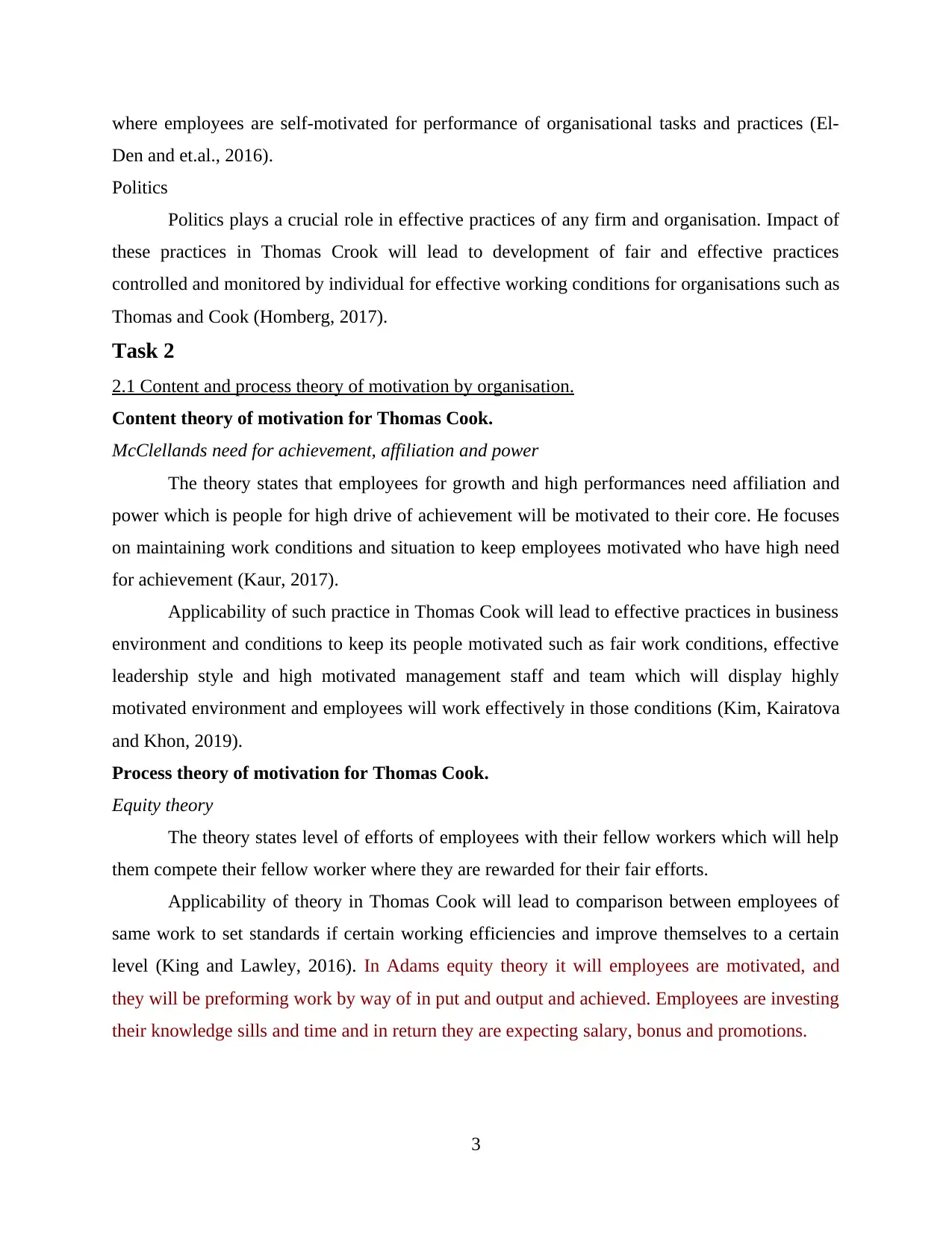
where employees are self-motivated for performance of organisational tasks and practices (El-
Den and et.al., 2016).
Politics
Politics plays a crucial role in effective practices of any firm and organisation. Impact of
these practices in Thomas Crook will lead to development of fair and effective practices
controlled and monitored by individual for effective working conditions for organisations such as
Thomas and Cook (Homberg, 2017).
Task 2
2.1 Content and process theory of motivation by organisation.
Content theory of motivation for Thomas Cook.
McClellands need for achievement, affiliation and power
The theory states that employees for growth and high performances need affiliation and
power which is people for high drive of achievement will be motivated to their core. He focuses
on maintaining work conditions and situation to keep employees motivated who have high need
for achievement (Kaur, 2017).
Applicability of such practice in Thomas Cook will lead to effective practices in business
environment and conditions to keep its people motivated such as fair work conditions, effective
leadership style and high motivated management staff and team which will display highly
motivated environment and employees will work effectively in those conditions (Kim, Kairatova
and Khon, 2019).
Process theory of motivation for Thomas Cook.
Equity theory
The theory states level of efforts of employees with their fellow workers which will help
them compete their fellow worker where they are rewarded for their fair efforts.
Applicability of theory in Thomas Cook will lead to comparison between employees of
same work to set standards if certain working efficiencies and improve themselves to a certain
level (King and Lawley, 2016). In Adams equity theory it will employees are motivated, and
they will be preforming work by way of in put and output and achieved. Employees are investing
their knowledge sills and time and in return they are expecting salary, bonus and promotions.
3
Den and et.al., 2016).
Politics
Politics plays a crucial role in effective practices of any firm and organisation. Impact of
these practices in Thomas Crook will lead to development of fair and effective practices
controlled and monitored by individual for effective working conditions for organisations such as
Thomas and Cook (Homberg, 2017).
Task 2
2.1 Content and process theory of motivation by organisation.
Content theory of motivation for Thomas Cook.
McClellands need for achievement, affiliation and power
The theory states that employees for growth and high performances need affiliation and
power which is people for high drive of achievement will be motivated to their core. He focuses
on maintaining work conditions and situation to keep employees motivated who have high need
for achievement (Kaur, 2017).
Applicability of such practice in Thomas Cook will lead to effective practices in business
environment and conditions to keep its people motivated such as fair work conditions, effective
leadership style and high motivated management staff and team which will display highly
motivated environment and employees will work effectively in those conditions (Kim, Kairatova
and Khon, 2019).
Process theory of motivation for Thomas Cook.
Equity theory
The theory states level of efforts of employees with their fellow workers which will help
them compete their fellow worker where they are rewarded for their fair efforts.
Applicability of theory in Thomas Cook will lead to comparison between employees of
same work to set standards if certain working efficiencies and improve themselves to a certain
level (King and Lawley, 2016). In Adams equity theory it will employees are motivated, and
they will be preforming work by way of in put and output and achieved. Employees are investing
their knowledge sills and time and in return they are expecting salary, bonus and promotions.
3
You're viewing a preview
Unlock full access by subscribing today!
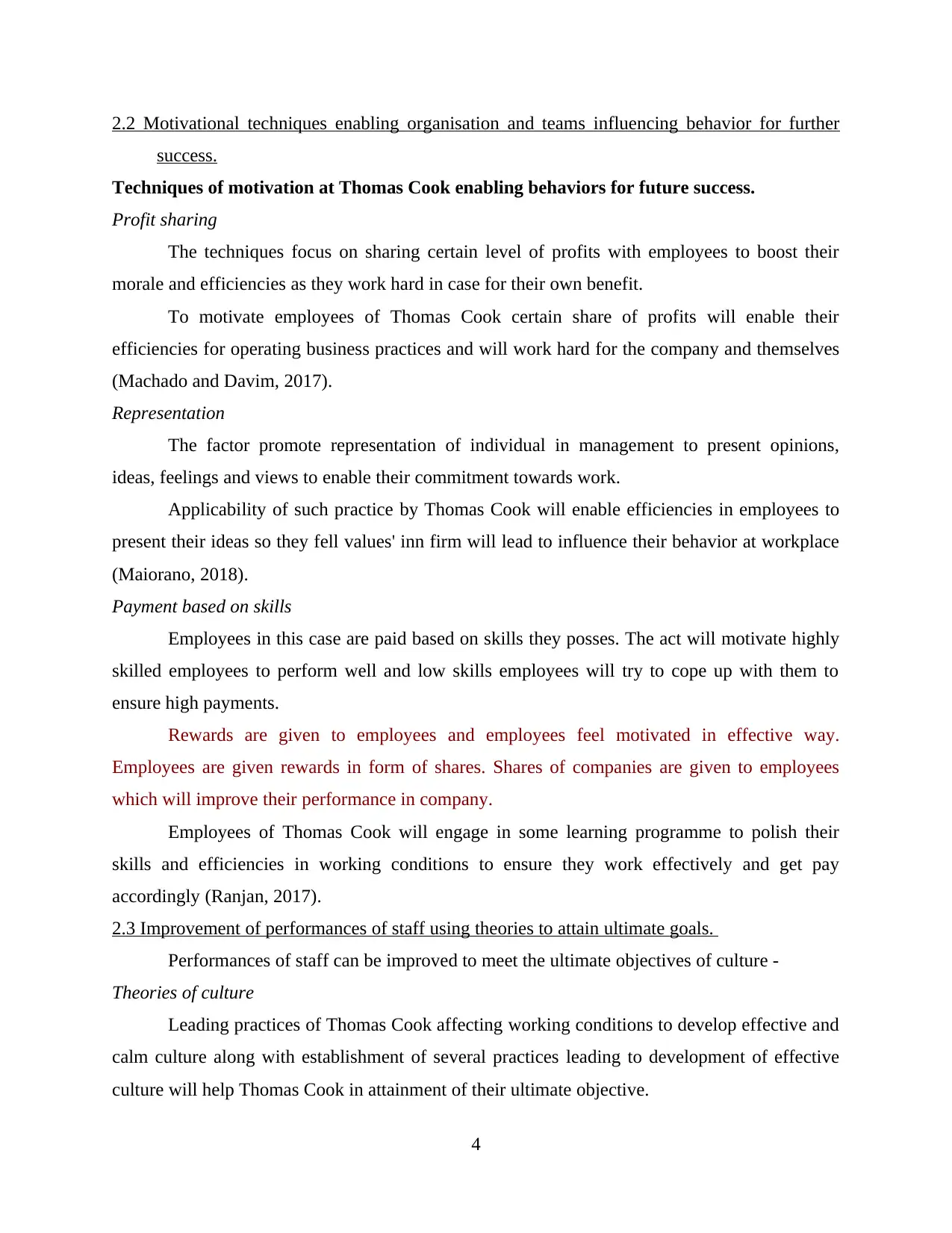
2.2 Motivational techniques enabling organisation and teams influencing behavior for further
success.
Techniques of motivation at Thomas Cook enabling behaviors for future success.
Profit sharing
The techniques focus on sharing certain level of profits with employees to boost their
morale and efficiencies as they work hard in case for their own benefit.
To motivate employees of Thomas Cook certain share of profits will enable their
efficiencies for operating business practices and will work hard for the company and themselves
(Machado and Davim, 2017).
Representation
The factor promote representation of individual in management to present opinions,
ideas, feelings and views to enable their commitment towards work.
Applicability of such practice by Thomas Cook will enable efficiencies in employees to
present their ideas so they fell values' inn firm will lead to influence their behavior at workplace
(Maiorano, 2018).
Payment based on skills
Employees in this case are paid based on skills they posses. The act will motivate highly
skilled employees to perform well and low skills employees will try to cope up with them to
ensure high payments.
Rewards are given to employees and employees feel motivated in effective way.
Employees are given rewards in form of shares. Shares of companies are given to employees
which will improve their performance in company.
Employees of Thomas Cook will engage in some learning programme to polish their
skills and efficiencies in working conditions to ensure they work effectively and get pay
accordingly (Ranjan, 2017).
2.3 Improvement of performances of staff using theories to attain ultimate goals.
Performances of staff can be improved to meet the ultimate objectives of culture -
Theories of culture
Leading practices of Thomas Cook affecting working conditions to develop effective and
calm culture along with establishment of several practices leading to development of effective
culture will help Thomas Cook in attainment of their ultimate objective.
4
success.
Techniques of motivation at Thomas Cook enabling behaviors for future success.
Profit sharing
The techniques focus on sharing certain level of profits with employees to boost their
morale and efficiencies as they work hard in case for their own benefit.
To motivate employees of Thomas Cook certain share of profits will enable their
efficiencies for operating business practices and will work hard for the company and themselves
(Machado and Davim, 2017).
Representation
The factor promote representation of individual in management to present opinions,
ideas, feelings and views to enable their commitment towards work.
Applicability of such practice by Thomas Cook will enable efficiencies in employees to
present their ideas so they fell values' inn firm will lead to influence their behavior at workplace
(Maiorano, 2018).
Payment based on skills
Employees in this case are paid based on skills they posses. The act will motivate highly
skilled employees to perform well and low skills employees will try to cope up with them to
ensure high payments.
Rewards are given to employees and employees feel motivated in effective way.
Employees are given rewards in form of shares. Shares of companies are given to employees
which will improve their performance in company.
Employees of Thomas Cook will engage in some learning programme to polish their
skills and efficiencies in working conditions to ensure they work effectively and get pay
accordingly (Ranjan, 2017).
2.3 Improvement of performances of staff using theories to attain ultimate goals.
Performances of staff can be improved to meet the ultimate objectives of culture -
Theories of culture
Leading practices of Thomas Cook affecting working conditions to develop effective and
calm culture along with establishment of several practices leading to development of effective
culture will help Thomas Cook in attainment of their ultimate objective.
4
Paraphrase This Document
Need a fresh take? Get an instant paraphrase of this document with our AI Paraphraser
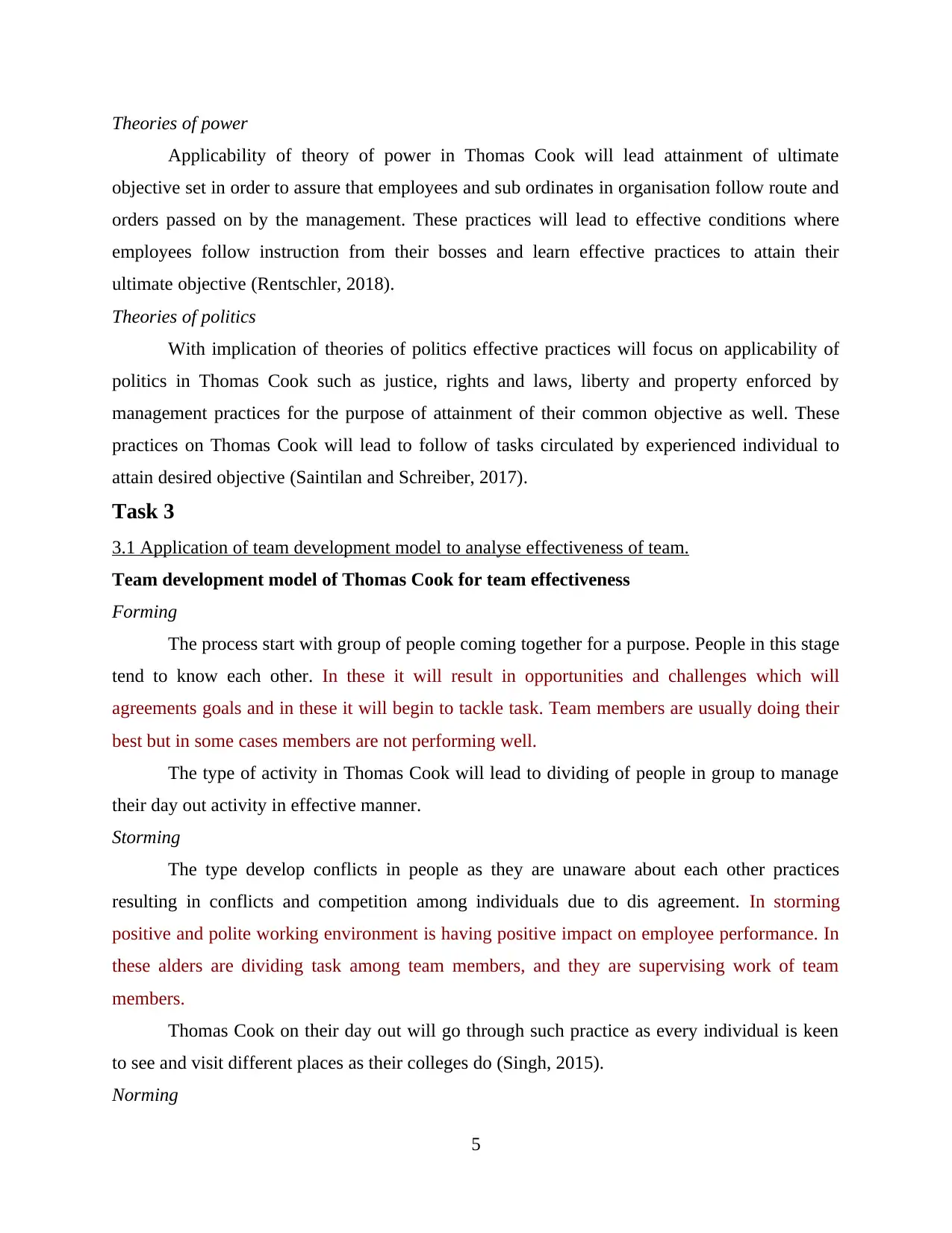
Theories of power
Applicability of theory of power in Thomas Cook will lead attainment of ultimate
objective set in order to assure that employees and sub ordinates in organisation follow route and
orders passed on by the management. These practices will lead to effective conditions where
employees follow instruction from their bosses and learn effective practices to attain their
ultimate objective (Rentschler, 2018).
Theories of politics
With implication of theories of politics effective practices will focus on applicability of
politics in Thomas Cook such as justice, rights and laws, liberty and property enforced by
management practices for the purpose of attainment of their common objective as well. These
practices on Thomas Cook will lead to follow of tasks circulated by experienced individual to
attain desired objective (Saintilan and Schreiber, 2017).
Task 3
3.1 Application of team development model to analyse effectiveness of team.
Team development model of Thomas Cook for team effectiveness
Forming
The process start with group of people coming together for a purpose. People in this stage
tend to know each other. In these it will result in opportunities and challenges which will
agreements goals and in these it will begin to tackle task. Team members are usually doing their
best but in some cases members are not performing well.
The type of activity in Thomas Cook will lead to dividing of people in group to manage
their day out activity in effective manner.
Storming
The type develop conflicts in people as they are unaware about each other practices
resulting in conflicts and competition among individuals due to dis agreement. In storming
positive and polite working environment is having positive impact on employee performance. In
these alders are dividing task among team members, and they are supervising work of team
members.
Thomas Cook on their day out will go through such practice as every individual is keen
to see and visit different places as their colleges do (Singh, 2015).
Norming
5
Applicability of theory of power in Thomas Cook will lead attainment of ultimate
objective set in order to assure that employees and sub ordinates in organisation follow route and
orders passed on by the management. These practices will lead to effective conditions where
employees follow instruction from their bosses and learn effective practices to attain their
ultimate objective (Rentschler, 2018).
Theories of politics
With implication of theories of politics effective practices will focus on applicability of
politics in Thomas Cook such as justice, rights and laws, liberty and property enforced by
management practices for the purpose of attainment of their common objective as well. These
practices on Thomas Cook will lead to follow of tasks circulated by experienced individual to
attain desired objective (Saintilan and Schreiber, 2017).
Task 3
3.1 Application of team development model to analyse effectiveness of team.
Team development model of Thomas Cook for team effectiveness
Forming
The process start with group of people coming together for a purpose. People in this stage
tend to know each other. In these it will result in opportunities and challenges which will
agreements goals and in these it will begin to tackle task. Team members are usually doing their
best but in some cases members are not performing well.
The type of activity in Thomas Cook will lead to dividing of people in group to manage
their day out activity in effective manner.
Storming
The type develop conflicts in people as they are unaware about each other practices
resulting in conflicts and competition among individuals due to dis agreement. In storming
positive and polite working environment is having positive impact on employee performance. In
these alders are dividing task among team members, and they are supervising work of team
members.
Thomas Cook on their day out will go through such practice as every individual is keen
to see and visit different places as their colleges do (Singh, 2015).
Norming
5
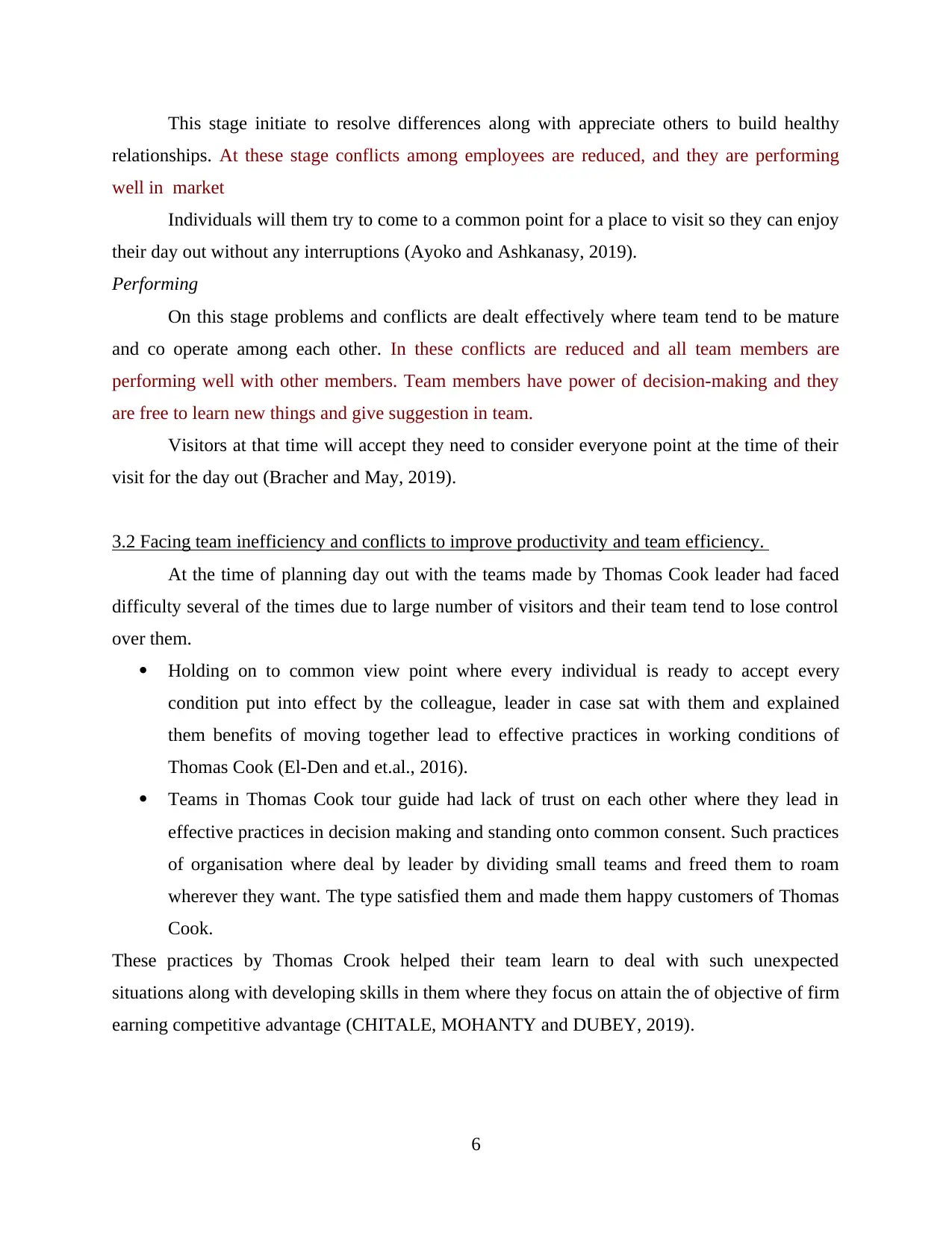
This stage initiate to resolve differences along with appreciate others to build healthy
relationships. At these stage conflicts among employees are reduced, and they are performing
well in market
Individuals will them try to come to a common point for a place to visit so they can enjoy
their day out without any interruptions (Ayoko and Ashkanasy, 2019).
Performing
On this stage problems and conflicts are dealt effectively where team tend to be mature
and co operate among each other. In these conflicts are reduced and all team members are
performing well with other members. Team members have power of decision-making and they
are free to learn new things and give suggestion in team.
Visitors at that time will accept they need to consider everyone point at the time of their
visit for the day out (Bracher and May, 2019).
3.2 Facing team inefficiency and conflicts to improve productivity and team efficiency.
At the time of planning day out with the teams made by Thomas Cook leader had faced
difficulty several of the times due to large number of visitors and their team tend to lose control
over them.
Holding on to common view point where every individual is ready to accept every
condition put into effect by the colleague, leader in case sat with them and explained
them benefits of moving together lead to effective practices in working conditions of
Thomas Cook (El-Den and et.al., 2016).
Teams in Thomas Cook tour guide had lack of trust on each other where they lead in
effective practices in decision making and standing onto common consent. Such practices
of organisation where deal by leader by dividing small teams and freed them to roam
wherever they want. The type satisfied them and made them happy customers of Thomas
Cook.
These practices by Thomas Crook helped their team learn to deal with such unexpected
situations along with developing skills in them where they focus on attain the of objective of firm
earning competitive advantage (CHITALE, MOHANTY and DUBEY, 2019).
6
relationships. At these stage conflicts among employees are reduced, and they are performing
well in market
Individuals will them try to come to a common point for a place to visit so they can enjoy
their day out without any interruptions (Ayoko and Ashkanasy, 2019).
Performing
On this stage problems and conflicts are dealt effectively where team tend to be mature
and co operate among each other. In these conflicts are reduced and all team members are
performing well with other members. Team members have power of decision-making and they
are free to learn new things and give suggestion in team.
Visitors at that time will accept they need to consider everyone point at the time of their
visit for the day out (Bracher and May, 2019).
3.2 Facing team inefficiency and conflicts to improve productivity and team efficiency.
At the time of planning day out with the teams made by Thomas Cook leader had faced
difficulty several of the times due to large number of visitors and their team tend to lose control
over them.
Holding on to common view point where every individual is ready to accept every
condition put into effect by the colleague, leader in case sat with them and explained
them benefits of moving together lead to effective practices in working conditions of
Thomas Cook (El-Den and et.al., 2016).
Teams in Thomas Cook tour guide had lack of trust on each other where they lead in
effective practices in decision making and standing onto common consent. Such practices
of organisation where deal by leader by dividing small teams and freed them to roam
wherever they want. The type satisfied them and made them happy customers of Thomas
Cook.
These practices by Thomas Crook helped their team learn to deal with such unexpected
situations along with developing skills in them where they focus on attain the of objective of firm
earning competitive advantage (CHITALE, MOHANTY and DUBEY, 2019).
6
You're viewing a preview
Unlock full access by subscribing today!
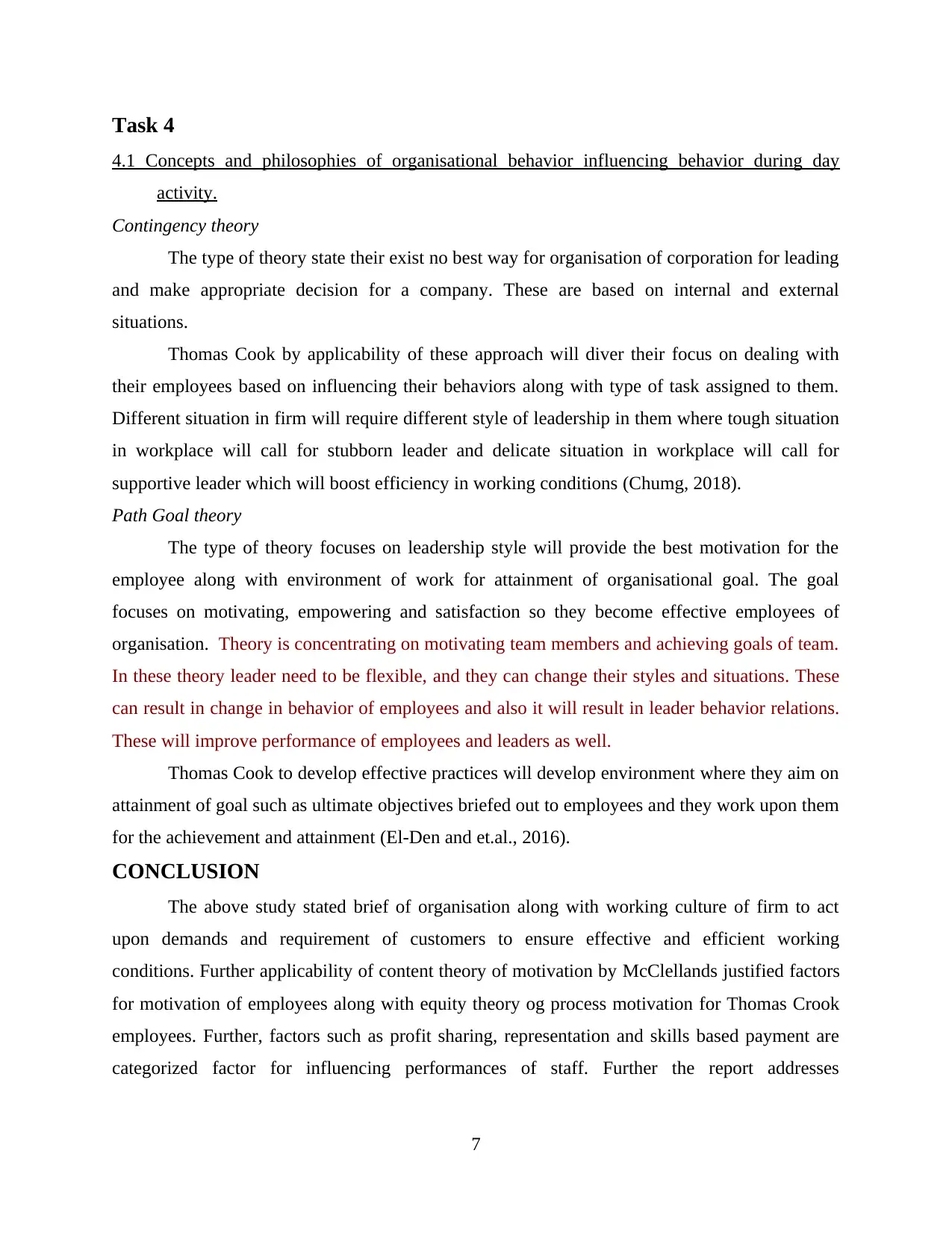
Task 4
4.1 Concepts and philosophies of organisational behavior influencing behavior during day
activity.
Contingency theory
The type of theory state their exist no best way for organisation of corporation for leading
and make appropriate decision for a company. These are based on internal and external
situations.
Thomas Cook by applicability of these approach will diver their focus on dealing with
their employees based on influencing their behaviors along with type of task assigned to them.
Different situation in firm will require different style of leadership in them where tough situation
in workplace will call for stubborn leader and delicate situation in workplace will call for
supportive leader which will boost efficiency in working conditions (Chumg, 2018).
Path Goal theory
The type of theory focuses on leadership style will provide the best motivation for the
employee along with environment of work for attainment of organisational goal. The goal
focuses on motivating, empowering and satisfaction so they become effective employees of
organisation. Theory is concentrating on motivating team members and achieving goals of team.
In these theory leader need to be flexible, and they can change their styles and situations. These
can result in change in behavior of employees and also it will result in leader behavior relations.
These will improve performance of employees and leaders as well.
Thomas Cook to develop effective practices will develop environment where they aim on
attainment of goal such as ultimate objectives briefed out to employees and they work upon them
for the achievement and attainment (El-Den and et.al., 2016).
CONCLUSION
The above study stated brief of organisation along with working culture of firm to act
upon demands and requirement of customers to ensure effective and efficient working
conditions. Further applicability of content theory of motivation by McClellands justified factors
for motivation of employees along with equity theory og process motivation for Thomas Crook
employees. Further, factors such as profit sharing, representation and skills based payment are
categorized factor for influencing performances of staff. Further the report addresses
7
4.1 Concepts and philosophies of organisational behavior influencing behavior during day
activity.
Contingency theory
The type of theory state their exist no best way for organisation of corporation for leading
and make appropriate decision for a company. These are based on internal and external
situations.
Thomas Cook by applicability of these approach will diver their focus on dealing with
their employees based on influencing their behaviors along with type of task assigned to them.
Different situation in firm will require different style of leadership in them where tough situation
in workplace will call for stubborn leader and delicate situation in workplace will call for
supportive leader which will boost efficiency in working conditions (Chumg, 2018).
Path Goal theory
The type of theory focuses on leadership style will provide the best motivation for the
employee along with environment of work for attainment of organisational goal. The goal
focuses on motivating, empowering and satisfaction so they become effective employees of
organisation. Theory is concentrating on motivating team members and achieving goals of team.
In these theory leader need to be flexible, and they can change their styles and situations. These
can result in change in behavior of employees and also it will result in leader behavior relations.
These will improve performance of employees and leaders as well.
Thomas Cook to develop effective practices will develop environment where they aim on
attainment of goal such as ultimate objectives briefed out to employees and they work upon them
for the achievement and attainment (El-Den and et.al., 2016).
CONCLUSION
The above study stated brief of organisation along with working culture of firm to act
upon demands and requirement of customers to ensure effective and efficient working
conditions. Further applicability of content theory of motivation by McClellands justified factors
for motivation of employees along with equity theory og process motivation for Thomas Crook
employees. Further, factors such as profit sharing, representation and skills based payment are
categorized factor for influencing performances of staff. Further the report addresses
7
Paraphrase This Document
Need a fresh take? Get an instant paraphrase of this document with our AI Paraphraser
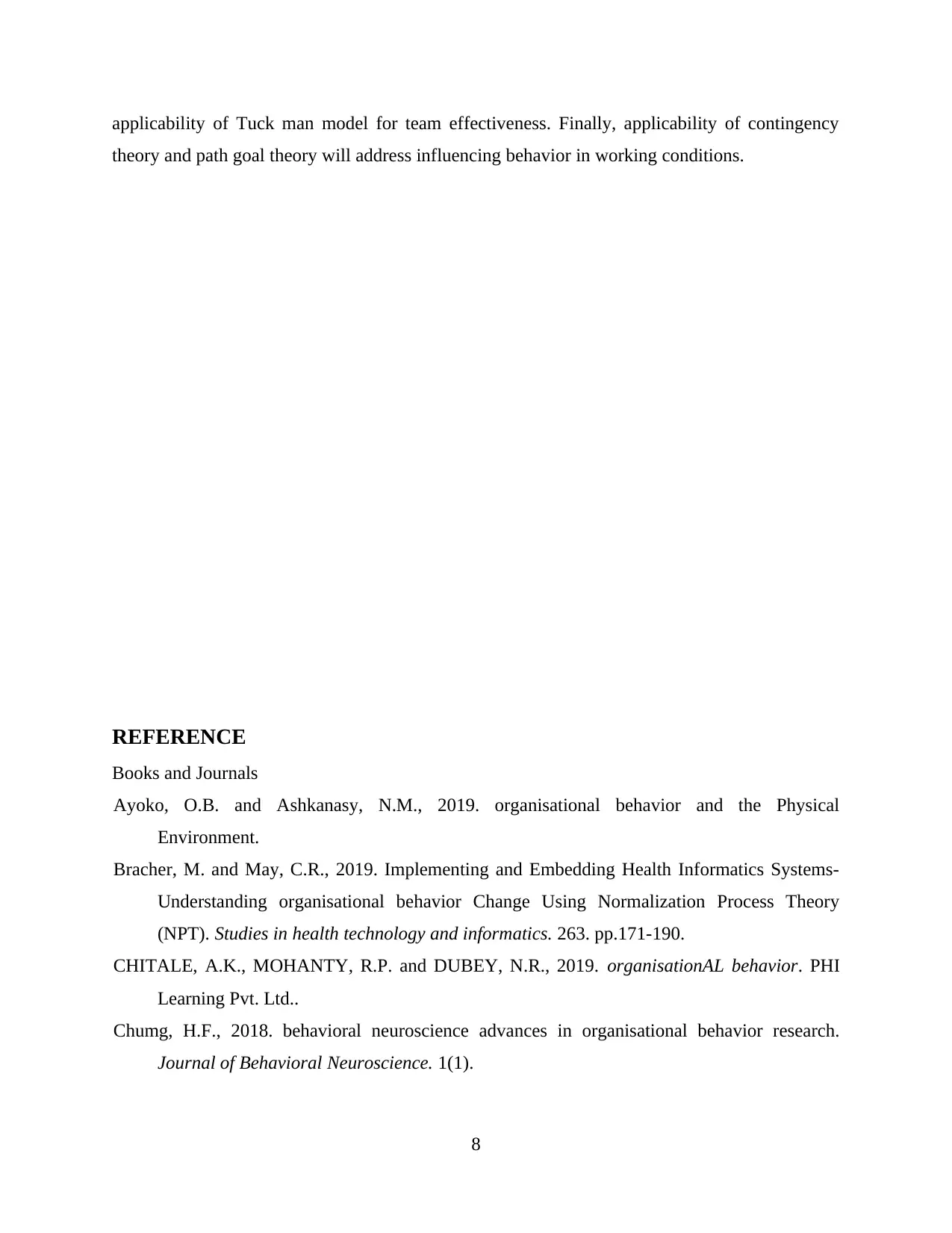
applicability of Tuck man model for team effectiveness. Finally, applicability of contingency
theory and path goal theory will address influencing behavior in working conditions.
REFERENCE
Books and Journals
Ayoko, O.B. and Ashkanasy, N.M., 2019. organisational behavior and the Physical
Environment.
Bracher, M. and May, C.R., 2019. Implementing and Embedding Health Informatics Systems-
Understanding organisational behavior Change Using Normalization Process Theory
(NPT). Studies in health technology and informatics. 263. pp.171-190.
CHITALE, A.K., MOHANTY, R.P. and DUBEY, N.R., 2019. organisationAL behavior. PHI
Learning Pvt. Ltd..
Chumg, H.F., 2018. behavioral neuroscience advances in organisational behavior research.
Journal of Behavioral Neuroscience. 1(1).
8
theory and path goal theory will address influencing behavior in working conditions.
REFERENCE
Books and Journals
Ayoko, O.B. and Ashkanasy, N.M., 2019. organisational behavior and the Physical
Environment.
Bracher, M. and May, C.R., 2019. Implementing and Embedding Health Informatics Systems-
Understanding organisational behavior Change Using Normalization Process Theory
(NPT). Studies in health technology and informatics. 263. pp.171-190.
CHITALE, A.K., MOHANTY, R.P. and DUBEY, N.R., 2019. organisationAL behavior. PHI
Learning Pvt. Ltd..
Chumg, H.F., 2018. behavioral neuroscience advances in organisational behavior research.
Journal of Behavioral Neuroscience. 1(1).
8
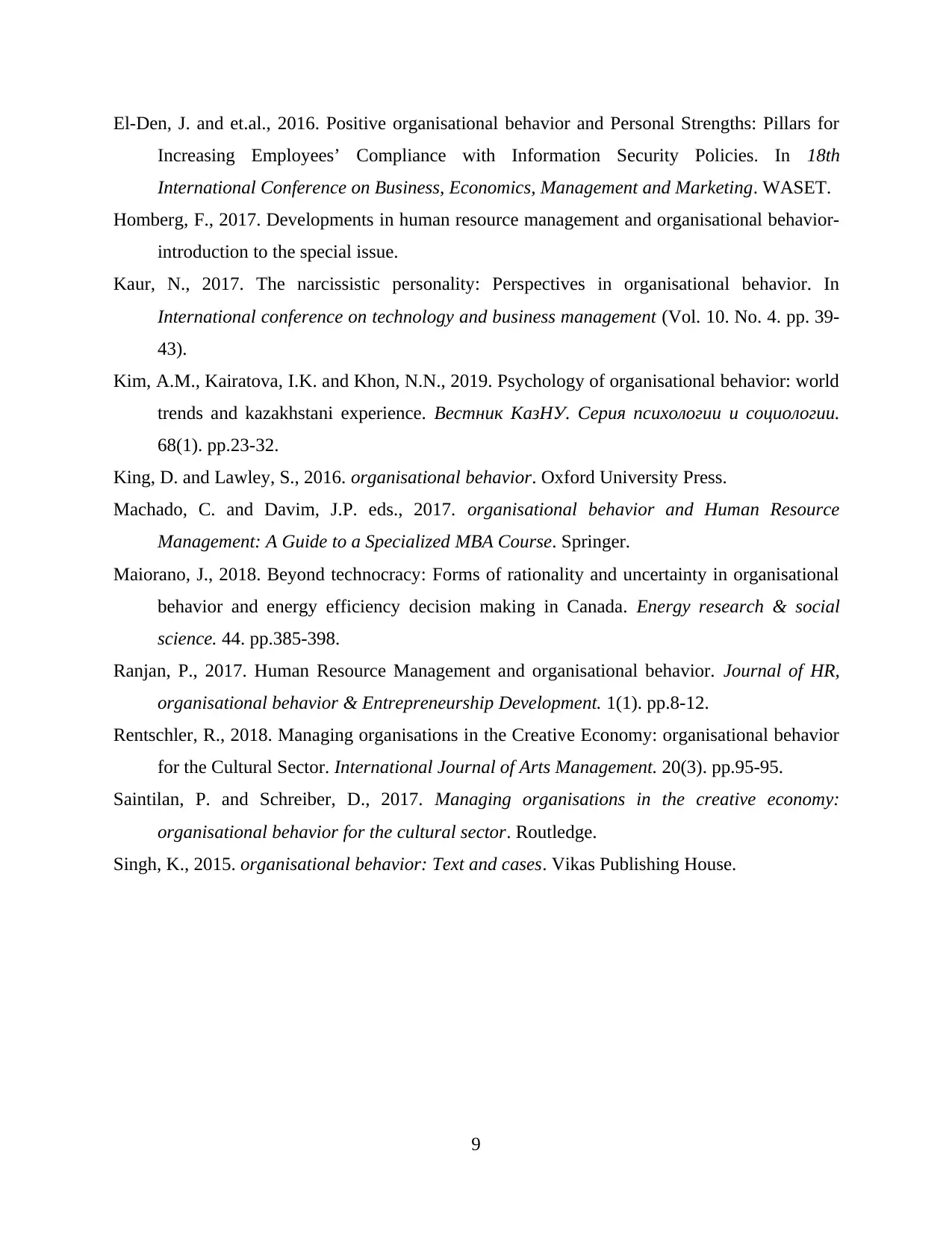
El-Den, J. and et.al., 2016. Positive organisational behavior and Personal Strengths: Pillars for
Increasing Employees’ Compliance with Information Security Policies. In 18th
International Conference on Business, Economics, Management and Marketing. WASET.
Homberg, F., 2017. Developments in human resource management and organisational behavior-
introduction to the special issue.
Kaur, N., 2017. The narcissistic personality: Perspectives in organisational behavior. In
International conference on technology and business management (Vol. 10. No. 4. pp. 39-
43).
Kim, A.M., Kairatova, I.K. and Khon, N.N., 2019. Psychology of organisational behavior: world
trends and kazakhstani experience. Вестник КазНУ. Серия психологии и социологии.
68(1). pp.23-32.
King, D. and Lawley, S., 2016. organisational behavior. Oxford University Press.
Machado, C. and Davim, J.P. eds., 2017. organisational behavior and Human Resource
Management: A Guide to a Specialized MBA Course. Springer.
Maiorano, J., 2018. Beyond technocracy: Forms of rationality and uncertainty in organisational
behavior and energy efficiency decision making in Canada. Energy research & social
science. 44. pp.385-398.
Ranjan, P., 2017. Human Resource Management and organisational behavior. Journal of HR,
organisational behavior & Entrepreneurship Development. 1(1). pp.8-12.
Rentschler, R., 2018. Managing organisations in the Creative Economy: organisational behavior
for the Cultural Sector. International Journal of Arts Management. 20(3). pp.95-95.
Saintilan, P. and Schreiber, D., 2017. Managing organisations in the creative economy:
organisational behavior for the cultural sector. Routledge.
Singh, K., 2015. organisational behavior: Text and cases. Vikas Publishing House.
9
Increasing Employees’ Compliance with Information Security Policies. In 18th
International Conference on Business, Economics, Management and Marketing. WASET.
Homberg, F., 2017. Developments in human resource management and organisational behavior-
introduction to the special issue.
Kaur, N., 2017. The narcissistic personality: Perspectives in organisational behavior. In
International conference on technology and business management (Vol. 10. No. 4. pp. 39-
43).
Kim, A.M., Kairatova, I.K. and Khon, N.N., 2019. Psychology of organisational behavior: world
trends and kazakhstani experience. Вестник КазНУ. Серия психологии и социологии.
68(1). pp.23-32.
King, D. and Lawley, S., 2016. organisational behavior. Oxford University Press.
Machado, C. and Davim, J.P. eds., 2017. organisational behavior and Human Resource
Management: A Guide to a Specialized MBA Course. Springer.
Maiorano, J., 2018. Beyond technocracy: Forms of rationality and uncertainty in organisational
behavior and energy efficiency decision making in Canada. Energy research & social
science. 44. pp.385-398.
Ranjan, P., 2017. Human Resource Management and organisational behavior. Journal of HR,
organisational behavior & Entrepreneurship Development. 1(1). pp.8-12.
Rentschler, R., 2018. Managing organisations in the Creative Economy: organisational behavior
for the Cultural Sector. International Journal of Arts Management. 20(3). pp.95-95.
Saintilan, P. and Schreiber, D., 2017. Managing organisations in the creative economy:
organisational behavior for the cultural sector. Routledge.
Singh, K., 2015. organisational behavior: Text and cases. Vikas Publishing House.
9
You're viewing a preview
Unlock full access by subscribing today!
1 out of 12
Related Documents
Your All-in-One AI-Powered Toolkit for Academic Success.
+13062052269
info@desklib.com
Available 24*7 on WhatsApp / Email
![[object Object]](/_next/static/media/star-bottom.7253800d.svg)
Unlock your academic potential
© 2024 | Zucol Services PVT LTD | All rights reserved.





